Run. Hide. Fight. is the survival strategy recommended by the Department of Homeland Security for active shooter situations. This involves three simple steps to increase someone’s chances of survival: run to safety if they can, hide if they can’t, and fight back if they are in imminent danger. Knowing and being prepared to do these is key in an active shooter situation and can make the difference in whether lives are lost or saved.
Introduction to Emergency Preparedness
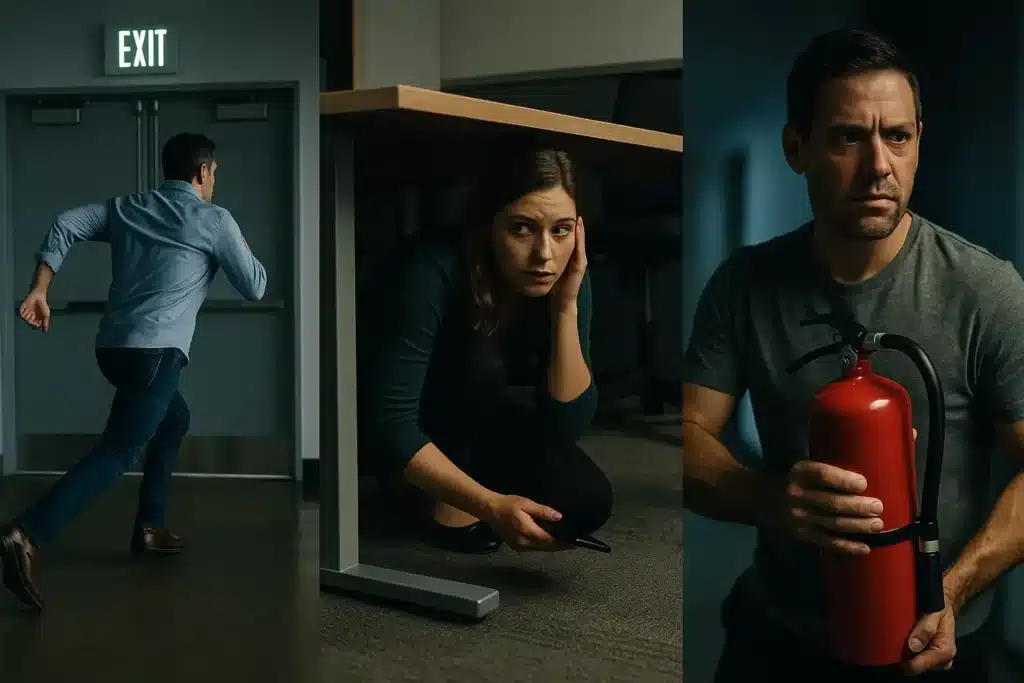
With the rise in mass shooting incidents, emergency preparedness is more important than ever, especially for active shooter situations that can happen so quickly. Knowing the basics of emergency preparedness is key for those people in harm’s way and can help protect them and others.
In these types of situations, local law enforcement is often the first to respond. Any information that can be provided to these teams – such as the shooter’s location, physical description and what type of weapon they have – is crucial for helping them apprehend the subject before lives are lost.
It’s also important for those in harm’s way to remain calm and use basic survival skills to ensure their safety. Having a plan in place, such as the “Run. Hide. Fight.” protocol, can help individuals respond much more effectively. Organizations should also create and regularly practice an Emergency Action Plan specifically for active shooter situations to ensure everyone knows what to do. This protocol should emphasize the importance of running to safety if possible, hiding in a secure place if running isn’t an option, and fighting back only as a last resort.
Being aware of your surroundings is another key aspect of emergency preparedness. For example, the simple process of noting potential hiding places, such as rooms with thicker walls or fewer windows, can lead to a person having better protection when they need it most. In an active shooter situation, prioritizing physical safety is crucial. That is why it’s important to lock doors, hide safely, and take steps to protect yourself.
Emergency preparedness also involves knowing potential escape routes and how to evacuate safely. Being prepared and having this type of plan can increase the chances of survival in an active shooter situation.
Core Takeaways
- Run first, get out as fast as you can, and get to a safe place while staying aware of your surroundings.
- If you can’t run, find a safe place to hide, minimize visibility and noise, and stay calm to increase your chances of survival.
- Only fight back as a last resort when you’re in imminent danger. Knowing when and how to act can be the difference between life and death.
Being prepared mentally and physically for an active shooter situation is key because it will help a person make quick decisions and protect themselves in these unpredictable and fast-moving situations.
Understanding Active Shooter Situations

An active shooter situation is when someone is actively trying to kill or harm people in a populated area. Unfortunately, these situations often result in multiple victims and deaths. Because these situations are unpredictable and can escalate quickly, it’s important to be prepared and know how to respond.
Active shooters often target people randomly. In these situations, survival is key, and people can protect themselves by hiding in a safe place or running to a safe location. In fact, this “Run. Hide. Fight.” protocol is the accepted response to active shooter situations by the Department of Homeland Security. Knowing the principles behind this protocol can increase someone’s chances of survival.
Active shooter situations typically happen quickly, so it’s important for people to be aware of their surroundings and take note of potential threats or suspicious behavior. Staying calm and making smart decisions is key to survival. Understanding active shooters’ motivations and behaviors can also help a person respond better in these situations.
Active shooter situations can adversely affect individuals as well as the entire community. That is why it’s vital to take the appropriate steps to prevent them from happening. This planning should also include mental health support for those affected to help individuals and communities recover from trauma.
Response Protocols
Having an emergency response plan in place is key when faced with an active shooter. The “Run. Hide. Fight.” strategy is an important part of this plan and can help guide people through the chaos that often ensues in these situations. This protocol states that as soon as an active shooter situation occurs, a person’s first priority should be to run safely where they can get as far away from the shooter as possible. This requires moving fast to get out of the immediate danger zone using any available exits that are away from the shooter.
If running isn’t an option, then the next best option is to hide safely. This means finding a secure room with locked doors, thicker walls and fewer windows to reduce visibility and provide protection from gunfire. Once inside, it’s important to lock the doors and barricade with heavy furniture if possible. And finally, if the person or group of people is hiding, they must try to be quiet and stay out of sight. This includes silencing cell phones and other electronics to avoid detection.
As a last resort, if a person is confronted and can’t escape or hide, they must be prepared to physically defend themselves and others. This may involve using improvised weapons or working with others to overpower the shooter. However, it’s important to note that active shooter situations can change rapidly, so staying calm, acting quickly and adapting as the situation evolves is key for survival.
The “Run” Strategy: Evacuate Safely
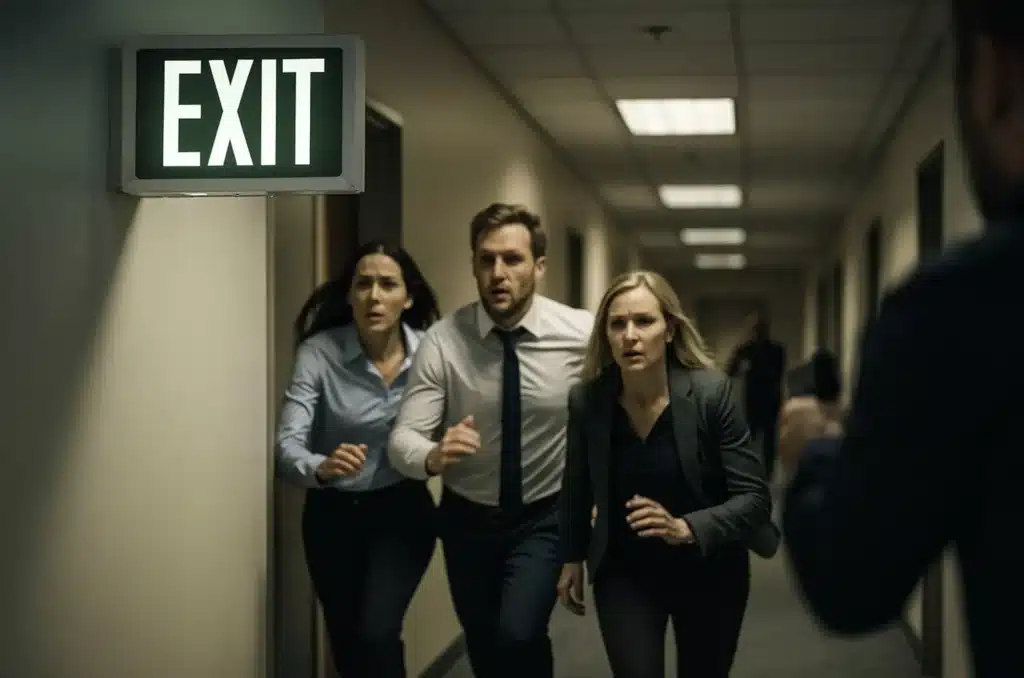
In an active shooter situation, a person’s first move should be to run. If they are far enough away from the shooter, they need to make it their top priority to get out of the area as fast as possible. This means not stopping or collecting personal items. Leaving these items behind will allow for a faster and unimpeded exit, enabling a person to get as much distance as possible between themselves and the threat.
As a person is running, they also need to be aware of their surroundings and avoid areas where shots are being fired. By consciously moving away from the gunfire, they will have a better chance of survival. And once in a safe area, they can then notify local authorities immediately about the active shooter situation. By providing as much detail as possible, they can help law enforcement mount an effective response that can save their life and the lives of others.
Time is of the essence in these kinds of situations. Running means making quick decisions without hesitation. For anyone in this situation, it’s important to remember that your safety comes first above all other considerations when figuring out how to get out of harm’s way as fast as possible.
Calling for Help and Reporting
When an active shooter is present, it’s critical to contact local law enforcement as soon as it is safe to do so. When someone calls for help, they can also give law enforcement clear and concise information about the active shooter situation. This includes where the shooter is located, how many people are involved, and a physical description of the shooter (clothing, height, any distinguishing features).
When law enforcement arrives on the scene, a person should be prepared to answer questions and provide any additional information that can help resolve the situation. This type of cooperation and clear communication can make a critical difference in how law enforcement responds to the active shooter.
Safe Rooms: Planning and Utilizing Secure Spaces
When faced with an active shooter situation, having a safe room or secure space can be the difference between life and death. A safe room is a designated hiding place chosen or designed to protect someone during an active shooter incident. The goal of a safe room is to hide safely and stay out of sight until law enforcement arrives.
Good planning for a safe room starts with choosing a location that is difficult for the shooter to easily access. This should include rooms with thicker walls, fewer windows and a solid core door that can be locked. These features will give a person protection from gunfire and reduce the chance of being seen or targeted. They should also choose a room where they can barricade the doors with heavy furniture for extra security.
Communication is key in a safe room. If possible, this room should have a phone or two-way radio so a person can call for help and give law enforcement critical information. When someone calls local law enforcement, they need to be prepared to give a description of the shooter, their location and the number of people involved.
If someone finds themselves in the situation where they can’t evacuate, they should move quickly to a safe room or find a hiding place that’s the most protected, such as behind a brick wall, a big tree, or in a corner away from doors and windows. Once inside, they can lock doors, close windows and silence phones and other electronics so they don’t draw attention. Staying calm and quiet during this time is also important.
If someone is confronted by the shooter and has no other options, they need to be prepared to use physical force only as a last resort. This might mean throwing things or using objects as weapons to defend themself to create an opportunity for them to escape.
The importance of survival skills and quick thinking in these situations can’t be overstated. Being prepared and knowing what to do in an active shooter situation can save lives, and safe rooms are a key part of this emergency planning. By identifying and using secure spaces, locking doors, silencing electronics and providing law enforcement with accurate information, a person can increase their chances of survival and help others. That is why it’s always important to “Run. Hide. Fight.” and be prepared to help law enforcement bring the situation to a safe resolution.
Effective Hiding Techniques

If a person cannot escape safely, their next best option is to find a safe place to hide. This means looking for places where they can be unseen and unheard, such as rooms with thick walls and few windows for added protection from bullets and reduced visibility.
When a person finds a safe place to hide, they should lock the doors if possible and barricade with any furniture available. This extra layer of security may buy them time until help arrives. And if outdoors, they should look for shelter behind objects such as brick walls or large trees that can provide cover from gunfire.
Silence is another key strategy for evading an active shooter. This includes turning off lights and muting phones and other devices to avoid detection. Quiet and calm may be the difference between life and death in these situations.
Self-Defense Techniques
In an active shooter situation, knowing basic self-defense can make a difference when all else has failed. While the goal should always be to run or hide safely, there may be moments during an active shooter incident where physical force is the last resort to save someone’s own life or the life of another person.
If someone is forced to confront an armed person, they should quickly scan their surroundings for anything that can be used as a weapon. This could include everyday objects such as fire extinguishers, chairs or even heavy books that can be used to distract or disable the shooter. These distractions can give someone time to escape or subdue the threat. However, it’s important to understand that the objective is not to engage in a long fight, but to create an opportunity to get away or stop the shooter from harming anyone else.
For anyone facing an active shooter incident, they should stay as calm as possible so they can think clearly in the face of danger. Using physical force should only be a last resort, such as when their life is in imminent danger.
Fighting as a Last Resort
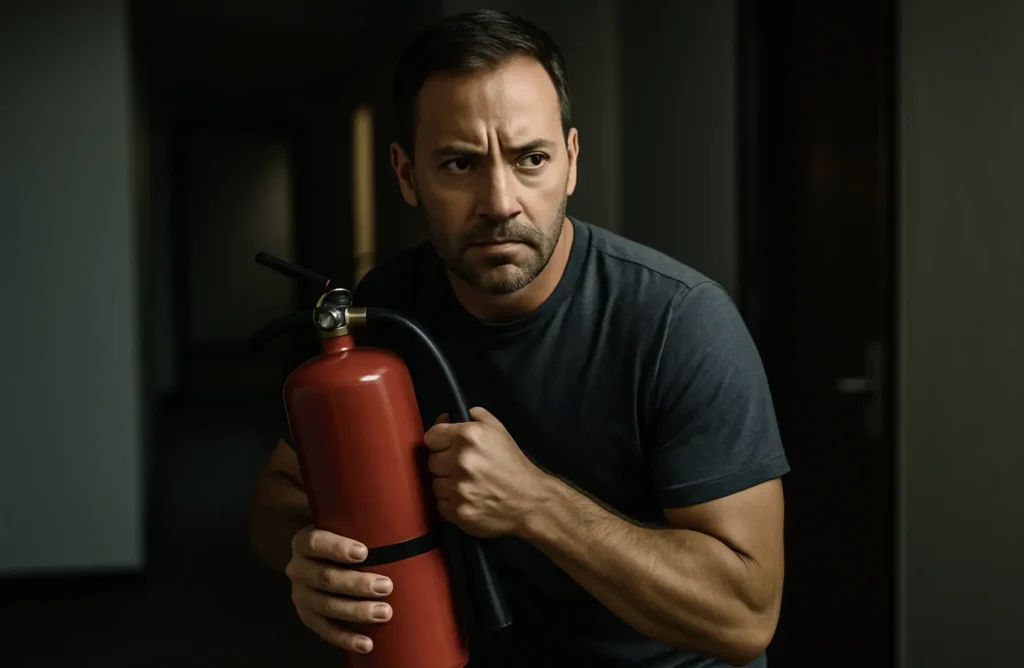
When all else fails and a person is in imminent danger, physical self-defense may be necessary. However, this should only be an option if the person feels their life is in danger and they have exhausted all other options.
If a person confronts the shooter directly, they need to use as much force as possible to disable them. The goal here is not to fight, but to create enough chaos for an escape or to overpower the attacker.
Everyone should know basic self-defense measures, even if they never have to use them. The “Fight” approach shows just how important survival skills are in extreme situations. While dangerous, these actions could save lives and possibly preserve life when there’s no other option.
Understanding each part of the “Run. Hide. Fight.” sequence is key to safety preparedness. As a rule, always try to escape first, then hide, and mentally and physically prepare yourself to fight if those options are not available.
Situational Awareness and Preparation
Being aware of your surroundings (situational intelligence) is key to survival during an active shooter event. Knowing the environment and how to get out quickly can mean the difference between life and death. Active shooters tend to be unpredictable, and dangerous situations can escalate quickly. That is why it’s so important to stay mentally alert and physically agile if you find yourself in one.
For starters, it’s important to understand the layout of where you are physically located. This includes knowing where the exits, hiding spots and safe zones are because having clear escape routes can help a person make quick, accurate decisions during a crisis. The more a person understands their surroundings, the higher their level of overall awareness and the better their chance at escape. In addition, it’s also a good best practice to develop an Emergency Action Plan that outlines procedures for different types of incidents that might occur in that particular location.
Fortunately, there are tools available that can help a person increase awareness at any given location. For example, training modules such as ALICE provide holistic approaches to active shooter situations by emphasizing situational awareness, lockdown techniques, immediate communication methods and defensive tactics, and constant vigilance and preparedness in communities.
By incorporating awareness into a daily routine and performing strategic readiness exercises, a person can be more efficient and prepared when an active shooter situation arises. Being vigilant allows someone to make quick decisions to protect themselves and others during these crises.
Technology and Active Shooter Detection
One of the most important developments in the fight against gun violence is the emergence of innovative new technologies designed to prevent or minimize active shooter situations. For example, visual AI gun detection from companies such as Omnilert provides real-time monitoring to identify threats and ensure a fast and robust response designed to save lives. Omnilert technology analyzes video feed from cameras already installed in a facility and can instantly detect a weapon the moment it is brandished.
Omnilert’s visual AI gun detection can also initiate a comprehensive response once a threat has been verified. This can include calling the police, locking doors, sounding alarms, sending alerts and more. When used with other preventative technologies such asmetal detectors,bulletproof windowsand automatic door locks, visual AI gun detection can provide better protection than anything that has been possible in the past. This multi-layered approach is key to preventing gun violence and helping to effectively deal with active shooter situations in any given location.
A fast response with actionable intelligence is what changes outcomes in a moment of potential gun violence. Omnilert Gun Detect can also provide detailed situational intelligence so that first responders know exactly where to go, who to look for, and what type of threat they face—ensuring a faster, more effective response.
Using this type of modern technology to detect active shooters and respond quickly to threats enables organizations to be proactive in keeping people safe. By integrating these systems into existing protocols already installed in a facility, organizations can create safer spaces where campus safety is amplified.
Psychological Preparedness
Being mentally prepared is just as important as being physically prepared when it comes to dealing with active shooter situations. These events tend to escalate quickly, and making smart decisions may mean the difference between life and death. For example, it’s important to note exits in advance and walk through various scenarios that will help make the right decisions during a crisis. The key is getting out of harm’s way, and once a person is safe, they can then get in touch with emergency services to ask for help.
Keeping your cool and controlling emotions plays a big part in the decisions a person makes and how well they respond under pressure. Mental preparation helps a person cope better with the anxiety and stress of active shooter situations, and this can help them survive.
Real-Life Examples and Lessons Learned
Reviewing what happened before and after an actual active shooter incident can provide life-changing insight into what works and what doesn’t in these situations. It also helps to highlight the need for providing mental health support for those affected, as well as comprehensive debriefings with all those involved after an incident has occurred. The knowledge gained from these interviews can help an organization to react better in the future, which can lead to better outcomes.
Sometimes organizations choose to use films and training simulations to help provide insight into active shooter situations by showing different scenarios and responses that could have taken place. This type of training can be helpful both before an incident takes place and post-event during the review and analysis phase. There is even a film called “Run. Hide. Fight.” that can help organizations better understand active shooter situations and provide best practices for dealing with them.
Looking back at past events reminds us that we need to continually improve public safety methods. Through the lessons learned from previous active shooter situations, an organization can be better prepared to face the next threat.
Training Programs and Resources (ALICE Training)
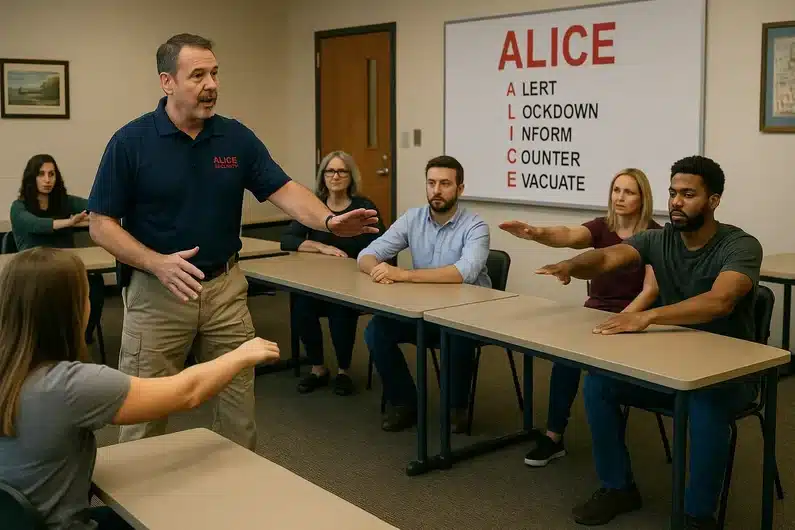
One tool that many organizations across the country are using to prepare for active shooter situations is ALICE Training. ALICE is the original civilian active shooter response training program delivered with a trauma-informed approach that involves the following steps:
- Alert– Be aware of your surroundings and recognize signs of danger through your senses or notifications like mobile alerts and announcements.
- Lockdown– ALICE’s enhanced lockdown strategy buys time and fortifies safety when evacuation isn’t possible, keeping individuals secure until help arrives.
- Inform– Real-time information saves lives. Sharing accurate, timely details with those in danger—such as intruder location or movement—helps guide decision-making.
- Counter– As a last resort, counter involves creating noise, movement, and distraction to disrupt the intruder’s focus. It is not synonymous with fighting.
- Evacuate– If safe, evacuate to distance yourself from the threat, using any available exits and moving to designated rally points, which should be practiced during drills.
This type of scenario-based training is important because it simulates intense situations that require quick thinking and action from the participants. Organizations can even choose to conduct private ALICE sessions designed for their specific security needs.
Investing in preparedness tools such as ALICE is key for providing local law enforcement with the tools to train law enforcement, students, employees, and anyone in a public setting how to more effectively deal with active shooter situations.
After an Emergency Situation
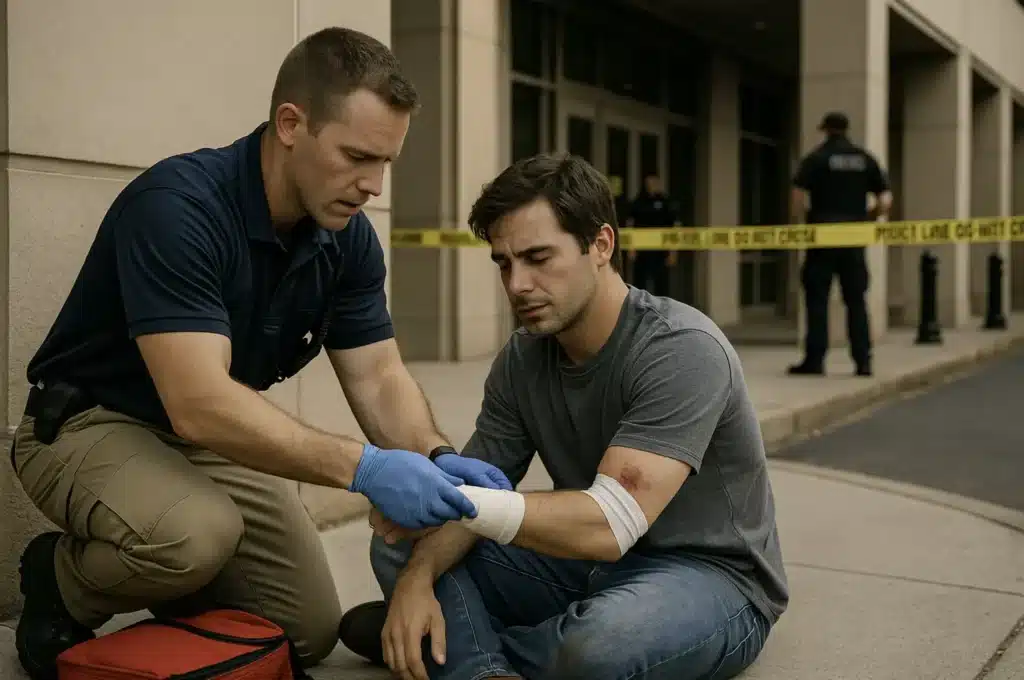
Once an active shooter situation is over, it’s important to evacuate the area safely and help those who were involved in the situation. This includes giving immediate medical attention to anyone injured and working with authorities to secure the scene.
Once everyone has been safely evacuated and given proper medical treatment, it’s important to review the incident and the response protocol to identify areas that could be improved in the future. This could take days or even months after an event takes place. This will help an organization identify areas to improve and highlight ways they can be better prepared for a future crisis. Providing mental support for those affected is also key, and this could involve counseling, support groups and other resources to help them process the trauma and start to heal.
By working together as a community and providing protection and support, organizations can help those affected by active shooter situations heal and work towards having a safer environment for the future. This should also include an ongoing review of emergency protocols, where changes can be made if needed to ensure the protocols are the most effective for the long term.
Final Thoughts on Run. Hide. Fight.
The “Run. Hide. Fight.” protocol developed by the FBI (official video above) is a vital strategy for surviving an active shooter incident. Knowing how to react and making the right decisions can make the difference between life and death. As a general rule, a person should always run to safety if they can, and if they can’t escape, they should find a safe place to hide. Once hidden, they should then lock doors, close windows and find a place with thicker walls, such as those made of brick, that will better protect them from potential gunfire.
Active shooter situations can evolve quickly, so it’s important for everyone involved to be aware of their surroundings and know how to get out safely. In schools and workplaces, having a plan and practicing survival skills can help everyone respond better in an active shooter situation. This may include watching the movie “Run. Hide. Fight.” which shows the importance of quick thinking and self-defense during an active shooter incident.
When law enforcement arrives at the scene of an active shooter incident, it’s vital to provide them with accurate information about the shooter as well as any details about the incident. This is where technologies such as Omnilert AI Gun Detection can help immensely because the software can provide law enforcement with actual images and video of the shooter and also track their location throughout the entire event. Knowing where the shooter is can help highlight safe evacuation routes for those inside the building who are not in immediate danger.
Being informed, practicing emergency protocols and being vigilant helps people reduce their risk of harm and helps protect themselves and others. If you find yourself in this type of scenario, it’s important to act fast, prioritize your safety and wait for law enforcement to get the situation under control.
Frequently Asked Questions (FAQs)
What is the protocol for an active shooter event?
The protocol is “Run. Hide. Fight.” This prioritizes getting out if a person can, hiding if they can’t and as a last resort, fighting to stay alive.
Who produced the “Run. Hide. Fight.” training video?
The City of Houston, with funding from the Department of Homeland Security (DHS), produced the video. The video can be found at this link on the FBI website.
What does the “Run” step in “Run. Hide. Fight.” mean?
If someone is far enough away from the shooter, the “Run” phase means they should get out as fast as they can. This entails leaving all personal items behind and only calling 911 once they are safe. For anyone involved in these situations, it’s important to put themselves first and get out of the area as quickly as possible.
What is the criticism of the “Hide” step in “Run. Hide. Fight.”?
Critics of the “Run. Hide. Fight.” protocol say the “Hide” step could be dangerous because it may cause people to stay in place and not flee, therefore increasing their chances of being found by the shooter. This is why the protocol stresses the importance of escaping first if possible and if safe to do so.
Could the “Fight” step in “Run. Hide. Fight.” be a problem?
The “Fight” option could be a problem depending on the individual involved. For example, this would not work well for frail elderly people or young children. However, for someone who is not compromised, this could help them if fighting were their only available option.



